INTRODUCTION
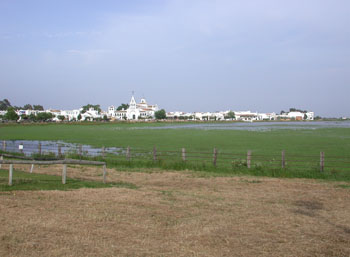
After Trinidad & Tobago in January we wanted a short-haul destination for our next trip and having enjoyed Spain in 2003, particularly Extremadura, we decided to return and visit some new sites and combine the trip with a visit to the Donana National Park, a new area for us. In Extremadura I particularly wanted to find Rock Thrush, whilst the attractions in Donana were Marbled Teal (Duck), Red-knobbed Coot and White-headed Duck, all of which would be lifers for me.
FLIGHTS
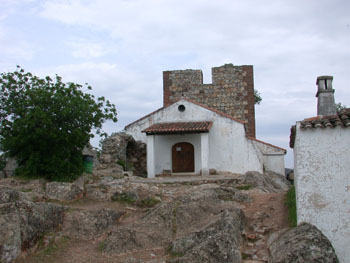 We used Skyscanner Flight Search to source cheap airline flights. The costs first shown on screen are misleading as they are not “live” and can be up to and over 24 hours old. You are taken to a screen with the option to confirm prices immediately and in our case, this involved an increase of c£15 over the originals. Taxes etc are only estimated and again, on going to the Airline’s own sites, (as Skyscanner do not have pre-booked allocated seats, being merely a search engine) prices increased by c £30. There was also a £6 booking charge by Monarch for a credit card booking. However, going direct to Monarch and using them both ways, would have cost an extra £25 with a flight 1 hour later at night. Therefore the overall result was not too bad. Flying Easyjet from Liverpool would have been much cheaper at £167.70 but the flight times were nowhere near as convenient for us with a 06.10 departure on the outward journey and 09.35 on the return.
We used Skyscanner Flight Search to source cheap airline flights. The costs first shown on screen are misleading as they are not “live” and can be up to and over 24 hours old. You are taken to a screen with the option to confirm prices immediately and in our case, this involved an increase of c£15 over the originals. Taxes etc are only estimated and again, on going to the Airline’s own sites, (as Skyscanner do not have pre-booked allocated seats, being merely a search engine) prices increased by c £30. There was also a £6 booking charge by Monarch for a credit card booking. However, going direct to Monarch and using them both ways, would have cost an extra £25 with a flight 1 hour later at night. Therefore the overall result was not too bad. Flying Easyjet from Liverpool would have been much cheaper at £167.70 but the flight times were nowhere near as convenient for us with a 06.10 departure on the outward journey and 09.35 on the return.
With extra legroom, the Monarch flight from Manchester to Faro was one of the most comfortable we have taken on this route. Check-in was quick and simple, with the seats already allocated. The flight was delayed as six passengers had been misled by an incorrect time shown on the Airport’s Departures screens, but, with generous flight times we were only 10 minutes late on arrival.
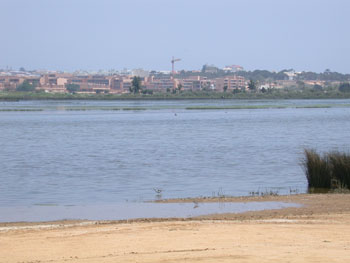 On the return flight with First Choice from Faro to Manchester we decided to pay €50 for extra legroom on one of the emergency exit rows – nothing is for free on cheap flights these days. Once again the flight was about 30 minutes late on departure, but arrived on time. The flight was comfortable and in flight service was good – passengers actually applauded the crew on landing in Manchester – never heard that before! Check-in at Faro was the usual nightmare with extensive slow moving queues. Having checked in we decided to get some food as we had not booked any with the flight; relative mistake. The main restaurant area upstairs was closed and the food options at the remaining outlets were not all available. The airport extension had been opened since our last visit and facilities in general are now much improved.
On the return flight with First Choice from Faro to Manchester we decided to pay €50 for extra legroom on one of the emergency exit rows – nothing is for free on cheap flights these days. Once again the flight was about 30 minutes late on departure, but arrived on time. The flight was comfortable and in flight service was good – passengers actually applauded the crew on landing in Manchester – never heard that before! Check-in at Faro was the usual nightmare with extensive slow moving queues. Having checked in we decided to get some food as we had not booked any with the flight; relative mistake. The main restaurant area upstairs was closed and the food options at the remaining outlets were not all available. The airport extension had been opened since our last visit and facilities in general are now much improved.
We decided to use Faro both for favourable prices and a Manchester departure and also to get some birding in on the way in slightly different habitats in Portugal. There are many options for this type of trip including Extremadura and Donana – Lisbon and Madrid both have good motorway connections to Trujillo whilst in the south Seville and Malaga provide good alternatives.
ACCOMMODATION
Our first night was based in Tavira, Portugal at Hotel Vila Gale Albacora (booked via Expedia). This is a delightful, modern 4* hotel close to the Parque Natural da Rio Formosa. Accommodation was very comfortable and the buffet breakfast and evening meal were excellent. The most comfortable night’s sleep of our trip without a doubt.
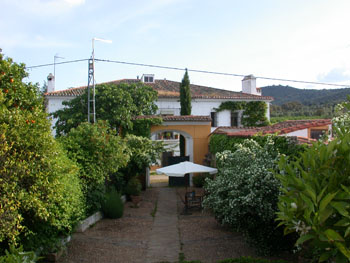 Attracted by the web site, we chose Finca Santa Marta 14 km south of Trujillo as our first base: email or phone +34 927 195937. The converted farmhouse and outbuildings retain all their original character and it was convenient for most of the sites we wished to visit. Rooms are spacious with a number of large common areas, as well as the dining room in the converted main barn. The only drawback was a slightly uncomfortable and small bed with a hard mattress and one continuous bolster instead of pillows. Food and service were excellent, with compliments to our host Henri Elink and his hardworking staff. Breakfasts were served from 8.30 and provided everything we could wish for. Dinner is a set menu, chosen by the cook and served at 20.30. We had our evening meal here on 3 of the 4 nights, which in itself tells the tale. In addition, there is also good birding in the Finca grounds – on our last morning we were able to watch a Hoopoe feeding four boisterous young on the lawn only 3 metres away, through a plate glass window in the dining room, as we enjoyed our breakfast.
Attracted by the web site, we chose Finca Santa Marta 14 km south of Trujillo as our first base: email or phone +34 927 195937. The converted farmhouse and outbuildings retain all their original character and it was convenient for most of the sites we wished to visit. Rooms are spacious with a number of large common areas, as well as the dining room in the converted main barn. The only drawback was a slightly uncomfortable and small bed with a hard mattress and one continuous bolster instead of pillows. Food and service were excellent, with compliments to our host Henri Elink and his hardworking staff. Breakfasts were served from 8.30 and provided everything we could wish for. Dinner is a set menu, chosen by the cook and served at 20.30. We had our evening meal here on 3 of the 4 nights, which in itself tells the tale. In addition, there is also good birding in the Finca grounds – on our last morning we were able to watch a Hoopoe feeding four boisterous young on the lawn only 3 metres away, through a plate glass window in the dining room, as we enjoyed our breakfast.
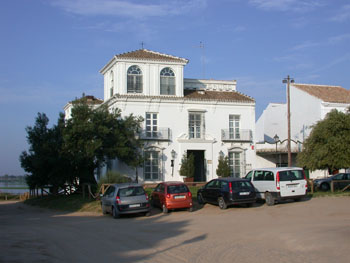 Moving on to Donana we chose Hotel Toruno in El Rocio. Phone 00 34 959 442323 – email hoteltoruno@eresmas.com. (Rooms 219-221-223-225 on the first floor have the best views over the Madre de las Marismas del Rocio – our room 107, was at the side of the hotel and looked over a corner of the marsh). The hotel is a fairly basic 2*. The rooms are a little cramped and the beds are very uncomfortable, but it was clean and acceptable for a short stay. The hotel is also very noisy with tile floors and no carpets to deaden the sound. We had a ground floor room and during the night and early morning, were awakened every time the toilets upstairs flushed, showers ran or baths were emptied. Unfortunately it is said to be the “best” hotel in the area and with no competition, prices are a little on the high side for what you get. Probably the nearest more upmarket hotel is situated in Matalascanas, but this is not as convenient for the main birding areas. Breakfast was at the hotel restaurant across the road and was a barely acceptable continental style – a big let down after Finca Santa Marta!
Moving on to Donana we chose Hotel Toruno in El Rocio. Phone 00 34 959 442323 – email hoteltoruno@eresmas.com. (Rooms 219-221-223-225 on the first floor have the best views over the Madre de las Marismas del Rocio – our room 107, was at the side of the hotel and looked over a corner of the marsh). The hotel is a fairly basic 2*. The rooms are a little cramped and the beds are very uncomfortable, but it was clean and acceptable for a short stay. The hotel is also very noisy with tile floors and no carpets to deaden the sound. We had a ground floor room and during the night and early morning, were awakened every time the toilets upstairs flushed, showers ran or baths were emptied. Unfortunately it is said to be the “best” hotel in the area and with no competition, prices are a little on the high side for what you get. Probably the nearest more upmarket hotel is situated in Matalascanas, but this is not as convenient for the main birding areas. Breakfast was at the hotel restaurant across the road and was a barely acceptable continental style – a big let down after Finca Santa Marta!
 El Rocio itself is a bit of a conundrum. Much is made of the unpaved, sandy streets, use of horses for local transport and the town’s resultant character. Quite frankly, after the novelty wears off, the sand gets everywhere, the roads are rutted and with deep sand in places, are waiting for cars to get stuck and the horsemen and women are a set of posers who seem to come out in the evenings to entertain the tourists. A lot of the buildings are in need of some TLC and whilst the photos may look picture postcard, the overall effect is a little down at heel.
El Rocio itself is a bit of a conundrum. Much is made of the unpaved, sandy streets, use of horses for local transport and the town’s resultant character. Quite frankly, after the novelty wears off, the sand gets everywhere, the roads are rutted and with deep sand in places, are waiting for cars to get stuck and the horsemen and women are a set of posers who seem to come out in the evenings to entertain the tourists. A lot of the buildings are in need of some TLC and whilst the photos may look picture postcard, the overall effect is a little down at heel.
FOOD
Evening meals at the Finca Santa Marta are excellent. There is a different set menu each night, with 4 courses and a bottle of local red wine, costing €28 each. Food is interesting, well cooked and beautifully presented. Contrast this with the one night we thought we may be too late to dine there when we went to Monfrague to search for Eagle Owls. 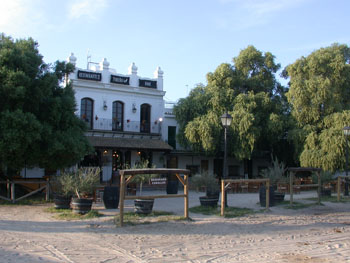 In the event we saw 3 birds before 18.00 and would have been back well before 20.30. Instead we went to Trujillo where, on a Wednesday evening, the only place open in the Plaza Mayor was Restaurante Bizcocho Plaza. Perhaps we cut the wrong impression as we had not “changed” for dinner and I was only wearing a t-shirt. The Maitre d’ was very off hand and surly and even though the restaurant notice board displayed an English menu, no one spoke English and, despite having English menus, we had to ask twice before we were given one to share between us. We both had a mushroom starter which had an unusual flavour to say the least and my main course salmon was partially uncooked. Vegetables were copious lettuce leaves. Seeing half my fish left on the plate the Maitre d’ approached to enquire whether or not we had enjoyed our meal. When I tried to explain the fish was partially raw he quickly shrugged his lack of comprehension and walked away. We had a half bottle of local white wine and for two disappointing courses paid the princely sum of €42 each. What a rip off!
In the event we saw 3 birds before 18.00 and would have been back well before 20.30. Instead we went to Trujillo where, on a Wednesday evening, the only place open in the Plaza Mayor was Restaurante Bizcocho Plaza. Perhaps we cut the wrong impression as we had not “changed” for dinner and I was only wearing a t-shirt. The Maitre d’ was very off hand and surly and even though the restaurant notice board displayed an English menu, no one spoke English and, despite having English menus, we had to ask twice before we were given one to share between us. We both had a mushroom starter which had an unusual flavour to say the least and my main course salmon was partially uncooked. Vegetables were copious lettuce leaves. Seeing half my fish left on the plate the Maitre d’ approached to enquire whether or not we had enjoyed our meal. When I tried to explain the fish was partially raw he quickly shrugged his lack of comprehension and walked away. We had a half bottle of local white wine and for two disappointing courses paid the princely sum of €42 each. What a rip off!
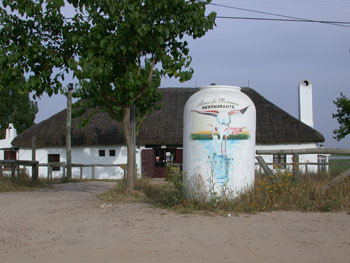 In El Rocio we had 4 meals at the Hotel Toruno Restaurant. The food here was good, reasonably priced and there was a much friendlier atmosphere, with most of the staff having a passing knowledge of English. If we go to Spain again we really will have to learn some of the language instead of being typically lazy British tourists. Our limitations were exposed once again when we dined at the nearby Aires de Donana Restaurante overlooking the marsh. Again, the waiters did not speak English. In my efforts to obtain a bottle of dry white wine I managed to order a bottle of dry fino sherry which tasted truly awful. The food was however good and when I eventually got the ordering of wine sorted, the waiter redeemed himself by only charging for 2 glasses of the fino sherry and earned himself a larger than usual tip. Meals in Donana for 2 courses and drinks plus a bottle of wine usually cost in the region of €30 each.
In El Rocio we had 4 meals at the Hotel Toruno Restaurant. The food here was good, reasonably priced and there was a much friendlier atmosphere, with most of the staff having a passing knowledge of English. If we go to Spain again we really will have to learn some of the language instead of being typically lazy British tourists. Our limitations were exposed once again when we dined at the nearby Aires de Donana Restaurante overlooking the marsh. Again, the waiters did not speak English. In my efforts to obtain a bottle of dry white wine I managed to order a bottle of dry fino sherry which tasted truly awful. The food was however good and when I eventually got the ordering of wine sorted, the waiter redeemed himself by only charging for 2 glasses of the fino sherry and earned himself a larger than usual tip. Meals in Donana for 2 courses and drinks plus a bottle of wine usually cost in the region of €30 each.
TRANSPORT
We picked up a Peugeot 206 hire car at Faro Airport from Europcar Portugal (via Holiday Autos). On arrival we were swiftly taken to the nearby depot to pick up our vehicle and after a quick check for marks and scratches, we were on our way. The assistant who showed us the car tried to explain in halting English that the petrol tank was full, despite the gauge showing slightly less than. It was faulty she explained – don’t believe them. With hindsight we should have asked them to take the car to the nearest garage and test it. Subsequent events confirmed the car had travelled at least 90 km since it was last full. This is only a minor grouse though. We had the misfortune to have a flying stone shatter the driver’s window at Finca Santa Marta at 09.30 on the Saturday morning we were due to leave for Donana. With Henri’s help we arranged for a new vehicle at the Europcar Caceres depot and by the noon closing time we were on our way again with a slightly more comfortable Fiat Punto. In all our dealings with Europcar we found their staff very helpful and what could have been quite a traumatic experience was in fact, quite stress free.
GUIDES
As we knew the Extremadura area from our previous visit we found our own birds with the help of John Muddeman’s A Birdwatching Guide to Extremadura.This is an excellent book, giving details of all the major sites, how to find them and the birds you are likely to see there. In the Itinerary each appropriate site carries a notation (e.g. M40 ) referring to the page on which the site can be found and no further directions are felt necessary.
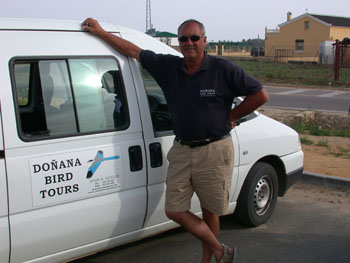
With Donana being a new area for us and the maps of the region not being up to Ordnance Survey standard we decided to use a local guide to help find my three target lifers and show us the best sites. We therefore contacted John Butler (RIP 15/9/07) of Doñana Bird Tours. Unfortunately, by the time we had decided our itinerary, John only had one day free, but he kindly agreed to let us follow him under our own steam for two days and benefit from his expertise (as well as lunch) for a reduced fee. The road signs are such, not to mention the numerous unsigned tracks, that we would not have been able to find some of the sites and birds without John’s assistance.
Although we did not have time to go on one of the 4 hour guided tours into the park in the 21-seater safari vehicles, it is advisable to book in advance at busy periods. Acebuche Visitor Centre Park Ranger Tour – 00 34 959 430432. For general information on the park including access, visitor centre details etc it is well worth visiting andalucia.com.
COSTS for two
- Monarch – flight including £30 for extra leg room – £154.99
- Holiday Autos – 4dr Manual with a/c & damage waiver excess of £25 – £186.42
- Hotel Vila Gale Albacora – B&B – £44.81
- Finca Santa Marta Extremadura – B&B x 4 nights – €340 (€85 per night inc tax) @1.46 – £232.88
- Hotel Toruno El Rocio – B&B x 5 nights – €401.25 (€80.25 per night inc tax) @1.46 – £274.83
- First Choice – flight excluding meal €18 – €105.40 @1.41 plus €50 for seats with extra legroom- £74.86 + £35.36
- John Butler – three days (two with own transport) €150 @1.46 – £102.74
- Fuel – €218.30 (2836km and 189.7 litres) @1.46 -£149.52
- Total – £1256.41 plus food and drink.
RESEARCH AND TRIP ESSENTIALS
The Fatbirder website is a good place to start, with comprehensive information on worldwide birding areas and numerous links to all the additional information required to plan a trip to most parts of the world. There are sections on both Extremadura and Andalucia.
Previous Trip Reports are best sourced via the Travellingbirder website.
The best site guide to Extremadura is A Birdwatching Guide to Extremadura by John Muddeman ISBN 1-900159-31-7. Unfortunately this book appears to be out of print at present but second hand copies are available from Amazon. The Finding Birds series by Dave Gosney also has titles covering both areas in Northern Spain and Southern Spain.


John Butler’s book Birdwatching on Spain’s Southern Coast ISBN 84-89954-38-0 has a small section on the Donana area. This information can be supplemented by the Doñana Bird Tours web site but don’t expect directions to all his favourite sites.
Good information on both areas can also be found in Where to Watch Birds in Southern and Western Spain: Andalucaia, Extremadura and Gibraltar by Ernest Garcia and Andrew Paterson ISBN-10: 0713683155.
Finally, I wouldn’t travel to Spain without Collins Bird Guide by Mullarney, Svensson, Zetterstrom & Grant ISBN 0-00-711332-3 (paperback).
WEATHER
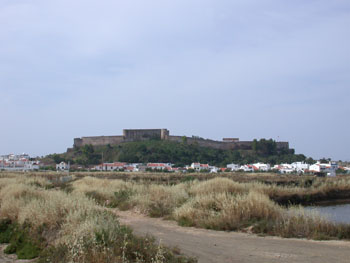 When we arrived in Faro at 17.30 it was sunny, almost cloudless and 22°. Although it was overcast in Portugal the next day, the sun broke through as we travelled into Spain but we had rain overnight. The next few days seemed to follow a similar pattern with sunshine for half of the day and clouds for the remainder, but luckily the rain seemed to arrive after dark each evening. The only time we had a specific problem was the morning of 4th May when the Finca was covered by low lying cloud, which persisted southwards and in the hills for the rest of the morning at least. On 6th we left Trujillo in bright sunshine and 23°, steadily increasing to 27° by the time we reached El Rocio. The remainder of the trip saw us enjoying wall to wall sunshine most of the time with temperatures building up to 32° and no rain in sight.
When we arrived in Faro at 17.30 it was sunny, almost cloudless and 22°. Although it was overcast in Portugal the next day, the sun broke through as we travelled into Spain but we had rain overnight. The next few days seemed to follow a similar pattern with sunshine for half of the day and clouds for the remainder, but luckily the rain seemed to arrive after dark each evening. The only time we had a specific problem was the morning of 4th May when the Finca was covered by low lying cloud, which persisted southwards and in the hills for the rest of the morning at least. On 6th we left Trujillo in bright sunshine and 23°, steadily increasing to 27° by the time we reached El Rocio. The remainder of the trip saw us enjoying wall to wall sunshine most of the time with temperatures building up to 32° and no rain in sight.
ITINERARY
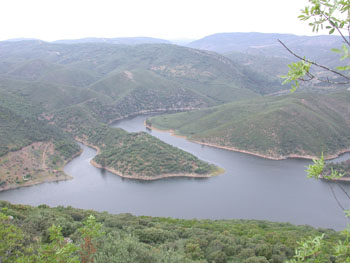
1st May – Depart Manchester 14.00 hrs on Monarch Flight No ZB 594 arrive Faro 17.10 hrs. Transfer to Hotel Vila Gale Albacora at Tavira for one night, birding at the salt pans on the way. Journey 51 km.
2nd May – Leave Tavira for Extremadura and 4 nights at the Finca Santa Marta near Trujillo – Birding at Tavira & Castro Marim in Portugal and along the N435 in Spain, plus Rio Ardila, Finca Santa Marta, Zorita & Madrigalejo (M78). Journey 506 km.
3rd May – Trujillo bull ring (M59), Belen Plains (M58), Santa Marta de Magasca (M53), Rio Almonte & Monfrague (M27) including Pena Falcon, Mirador de la Bascula & Portilla del Tietar (M31). Journey 254 km.
4th May – We set out for Cabanas del Castillo in the Sierras de Villuercas (M60) but turned back about 10 km north of Logrosan in view of low cloud and poor visibility. Embalse de Arroyocampo (M40), Trujillo to Monroy road (M55), stopping 15 km short of Monroy and returning via Santa Marta de Magasca. Journey 300 km.
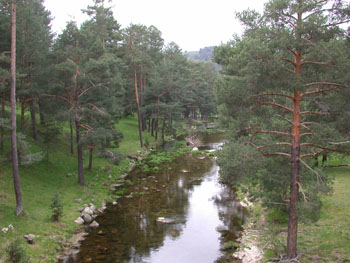
5th May – Sierra de Gredos (M17), Valle del Jerte (M19) & Embalse de Arroyocampo (M40). Journey 471 km.
6th May – Depart Trujillo for El Rocio & 5 nights at the Hotel Toruno. Birding at El Acebuche on arrival. Journey 430 km.
7th May – El Rocio marshes, Palacio de Acebron, La Rocina, El Acebuche, Matalascanas and the El Rocio to Villamanrique road. Journey 130 km.
8th May – Lagunas de Mancho Zurillo, Corredor Verde de Guadiamar, Turf Farm, Canada de Rianzuela, gravel pit at La Venta del Cruce, Dehasa de Abajo, Lucio del Lobo, Jose Antonio Valverde Visitor Centre, Cano de Guadiamar & Casa de Bombas with John Butler. Pick up Hotel reception 08.30. Own Transport – cost €40. 22.00 visit to La Rocina – Palacio de Acebron road. Journey 178 km.
9th May – Niebla, Laguna de Balustrera, San Juan del Puerto, La Rabida, Laguna El Portil, Marismas de Rio Pedras/El Rompido & Marismas del Odiel, with John Butler. Pick up Hotel Reception 09.00. Cost €70. 22.00 visit to La Rocina – Palacio de Acebron road.
10th May – Jardines Botanico de Buitrago near Aznalcollar, Corredor Verde de Guadiamar, Canada de Rianzuela & Brazo del Este Natural Park and the east bank of the Rio Guadalquivir, crossing the Rio Guadalquivir by ferry at Coria del Rio (current charges are €2.05 for the vehicle and driver and €0.40 per passenger, each way) with John Butler. Pick up at Villamanrique 09.15. Own Transport – Cost €40. Journey 212 km.
11th May – Depart El Rocio for Faro with flight at 18.25 hrs arriving Manchester 21.20 hrs on First Choice Flight No FCA 2401. Birding on the way in Portugal at Castro Marim with a diversion to Pera Marsh in view of time available. Journey 304 km.
SITE REVIEW (Cast in order of appearance)
Black-winged Stilt, Avocet, Dunlin, White Stork, Cattle Egret, Black Kite, Bee-eater, Crested Lark, Serin, Hoopoe, Spotless Starling, Azure-winged Magpie and Corn Bunting were seen in good numbers in all suitable habitats and too numerous to mention individually.
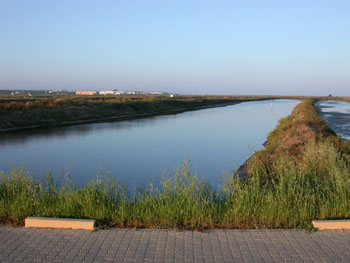
Situated to the SE of the town and bordering on the Parque Natural da Rio Formosa. Water levels around the pans were reasonable with a good spread of waders, nearly all in summer plumage. Birds on 1st & 2nd May included c60 brick red Curlew Sandpiper, Whimbrel, Kentish Plover, Black-tailed Godwit and Greenshank. Three Spoonbill flew overhead along with Little Tern whilst Linnet, Sardinian Warbler and two Great Spotted Cuckoo were at the roadside. Red-rumped Swallow were breeding around the Hotel Vila Gale Albacora and there was an early morning passage of over 100 Gannet out to sea.
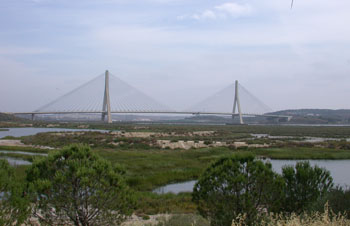 Almost immediately after coming off the Motorway at the Castro Marim/Villa Real de Santo Antonio turn off and heading south towards the town there is a track on the left into the salt pans. When we went down this track in January a few years ago there were good numbers of waders around. We visited on 2nd May and on our return to Portugal on 11th May. Most of the waders were on passage and numbers were much higher at the beginning of the month. We saw Little Tern, Gull-billed Tern, Kentish Plover, Curlew Sandpiper, Ruff, Grey Plover, Little Stint, Zitting Cisticola, Yellow Wagtail (iberiae), Hoopoe and Southern Grey Shrike amongst others. The wetlands around this area are all part of the Reserva Natural do Sapal de Cartro Marim e Vila Real St. Antonio and there is a modern Visitor Centre with wash rooms which can be reached by taking the first track (which is signed for the reserve) on the right, heading north after coming off the Motorway.
Almost immediately after coming off the Motorway at the Castro Marim/Villa Real de Santo Antonio turn off and heading south towards the town there is a track on the left into the salt pans. When we went down this track in January a few years ago there were good numbers of waders around. We visited on 2nd May and on our return to Portugal on 11th May. Most of the waders were on passage and numbers were much higher at the beginning of the month. We saw Little Tern, Gull-billed Tern, Kentish Plover, Curlew Sandpiper, Ruff, Grey Plover, Little Stint, Zitting Cisticola, Yellow Wagtail (iberiae), Hoopoe and Southern Grey Shrike amongst others. The wetlands around this area are all part of the Reserva Natural do Sapal de Cartro Marim e Vila Real St. Antonio and there is a modern Visitor Centre with wash rooms which can be reached by taking the first track (which is signed for the reserve) on the right, heading north after coming off the Motorway.
Rio Ardila
Heading north from Huelva on the N435 Andalucia merges into Extremadura and at Fregenal our route took us on to the Ex101. After about 25 km the road crosses the Rio Ardila. There is a track on the right, immediately before the bridge which presents an ideal opportunity to take a break into potentially good habitat. A 20 minute stop produced 2 Griffon Vulture, Lesser Kestrel, Booted Eagle, as well as the obligatory Black Kite along with Roller, Red-rumped Swallow and Little Ringed Plover. We had previously stopped at one of the few “lay-bys” on the N435 and in the wooded area around the road seen our only Nuthatch of the trip plus the first of only two sightings each of Wren, Robin and Blackcap.
Finca Santa Marta
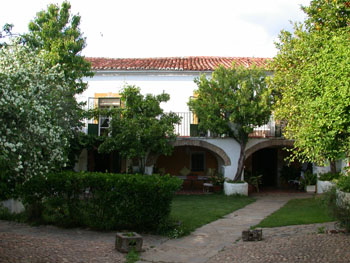
The Finca and surrounding area has an impressive bird list, but with so many other new places we wished to visit, we didn’t really do it justice. Nightingale song and Hoopoe calls greeted us as we arrived with both species nesting in the grounds, along with Quail & Scops Owl. We saw our first Melodious Warbler of the trip here.
Zorita & Madrigalejo (M78)
Nothing special travelling through Zorita other than Whinchat at the roadside. At Madrigalejo, on the small road immediately left, prior to the bridge over the river and ultimately running almost parallel to it, we pinned down our first singing Nightingale and Cetti’s Warbler as well as our only Willow Warbler, Osprey and Red Avadavat, with a mobile flock of c40 birds. Heading south out of the town we saw a pair of Roller and our only Turtle Dove of the trip, with an elusive Quail calling in fields right at the side of the road, giving us 30 minutes of frustration as we tried to locate the annoying little bird. As we motored back to the Finca we saw a pair of Great Spotted Cuckoo at the roadside.
Trujillo bull ring (M58) & Belen Plains (M59)
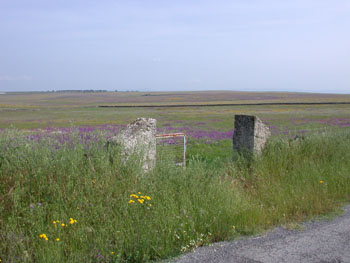
As anticipated the bull ring produced good views of Lesser Kestrel which were nesting in the roof. As always around Trujillo the sky was full of hirundines as well as Lesser Kestrel, including Pallid Swift. Moving on to the Belen Plains, our first new site, we saw our first Red Kite, Raven, Black Vulture and Whitethroat along with the only 2 Great Bustard of the trip. We heard Little Bustard calling but they remained elusive and as we had had excellent views of both bustards and sandgrouses on our previous trip to Extremadura we did not linger on this occasion as all four species were difficult to locate in the long grass and wild flowers.
Santa Marta de Magasca (M53)
An area previously so productive for the four plains species mentioned above, let us down on this trip, but again we didn’t linger specifically seeking them out. We saw our only Mistle Thrush in the Olive Groves at the side of the road to St Marta, along with our first Golden Eagle and Chaffinch. We stopped by the Rio Magasca on the road from the town towards Caceres and had good views of Cuckoo, Crag Martin, White Wagtail and Little Ringed Plover. As we headed out of the river valley back to the plains we saw our first stunning male Montagu’s Harrier, a bird I could watch floating across the fields for hours at a time.
Rio Almonte (M50)
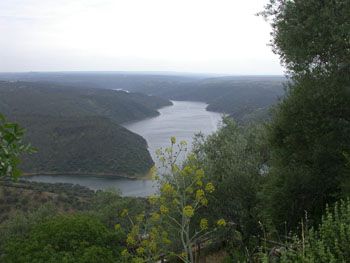
A good stopping place on the road from Caceres to Torrejon el Rubio, there are tracks down to the river on either side of the bridge. The area is reliable for Alpine Swift and we saw the only four birds of the trip amongst the numerous hirundines. We also had a Black Vulture soaring with Griffon Vulture over the river and a few miles further along the road towards Torrejon we managed to pull off on to a gated track to watch a pair of Short-toed Eagle linger just over our heads as they floated above the treetops.
Monfrague (M27)
We visited several of the well known stopping places and encountered most of the usual suspects as we drove through the park towards the Portilla del Tietar. We visited the Castillo de Monfrague for the first time, driving up to the top car park. The subsequent steep climb to the Castillo is well worth it for the magnificent views around the park. We didn’t pick up any new species however. 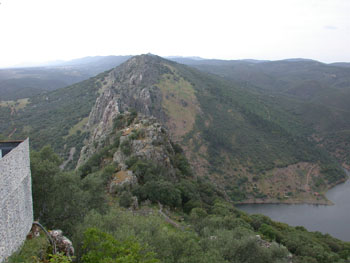 At Pena Falcon we saw Blue Rock Thrush, Raven and Rock Bunting, along with numerous vultures and hirundines. Our main goal at the Portilla del Tietar, Eagle Owl, was surprisingly easy to find. As we arrived at the watch point there were numerous British and European birders being delighted by the antics of the two juvenile owls as they moved around the nesting ledge. Apparently they had only just shown themselves as we arrived, with some of the watchers having patiently scoped the nest site for over two hours. Spanish Imperial Eagle was also nesting in trees at the side of the same crag and the male was soaring over the numerous vultures which also nest here. Busy watching the Eagle, I nearly missed two Common Terns flying along the river and didn’t really pay much attention to the supporting cast of Booted Eagle, Black Vulture and Rock Bunting. After watching the juveniles for about 20 minutes, one bird I didn’t miss was one of the Eagle Owl parents as it glided past the nest and landed on a ledge under a tree about 20 metres away. This magnificent bird was still sat in its resting place as we left the site 30 minutes later, having provided us with much better views than on our trip in 2003 when we only caught a fleeting glimpse of a bird in flight as dusk descended. As we headed back to Trujillo we saw our only Black Stork and also two Egyptian Vultures perched on the hillside at the Mirador de la Bascula. A little further along the road, before Villareal de San Carlos, we came across a spanking singing male Black-eared Wheatear on the top of a small roadside tree conveniently by a large lay-by.
At Pena Falcon we saw Blue Rock Thrush, Raven and Rock Bunting, along with numerous vultures and hirundines. Our main goal at the Portilla del Tietar, Eagle Owl, was surprisingly easy to find. As we arrived at the watch point there were numerous British and European birders being delighted by the antics of the two juvenile owls as they moved around the nesting ledge. Apparently they had only just shown themselves as we arrived, with some of the watchers having patiently scoped the nest site for over two hours. Spanish Imperial Eagle was also nesting in trees at the side of the same crag and the male was soaring over the numerous vultures which also nest here. Busy watching the Eagle, I nearly missed two Common Terns flying along the river and didn’t really pay much attention to the supporting cast of Booted Eagle, Black Vulture and Rock Bunting. After watching the juveniles for about 20 minutes, one bird I didn’t miss was one of the Eagle Owl parents as it glided past the nest and landed on a ledge under a tree about 20 metres away. This magnificent bird was still sat in its resting place as we left the site 30 minutes later, having provided us with much better views than on our trip in 2003 when we only caught a fleeting glimpse of a bird in flight as dusk descended. As we headed back to Trujillo we saw our only Black Stork and also two Egyptian Vultures perched on the hillside at the Mirador de la Bascula. A little further along the road, before Villareal de San Carlos, we came across a spanking singing male Black-eared Wheatear on the top of a small roadside tree conveniently by a large lay-by.
Embalse de Arroyocampo (M40)
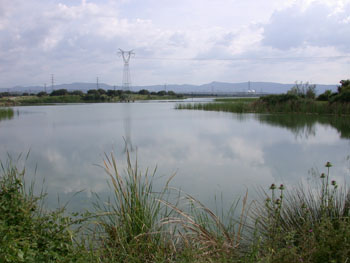
Another site we had not visited previously; we struck lucky immediately on arrival with fleeting views of Little Crake, followed by our only Great White Egret of the trip and the first of many subsequent Purple Heron, Purple Swamphen, Black-crowned Night Heron, Marsh Harrier and Great Reed Warbler. Little Bittern, Spanish Sparrow and Cetti’s Warbler quickly followed along with a Penduline Tit, which was nesting at the site. As we drove away from the site back to the motorway, two Black-shouldered Kites flew low over the road, giving us great views. We were so impressed with this site we returned the following day on our way back from the Sierra de Gredos. Although we didn’t see any new birds, we had Little Egret as well as most of the species seen the previous day, along with Penduline Tit feeding four freshly fledged young. This excellent site is only 60 km north of Trujillo, with motorway for 95% of the journey and has the added bonus of Services and a restaurant on the island immediately after the exit road.
Trujillo to Monroy road (M55)
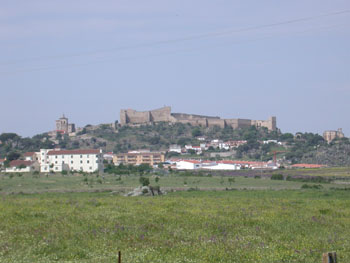
Another road through the plains well worth a visit (our first) where we saw Great Spotted Cuckoo, c30 Spanish Sparrow, the only 2 Little Owl of our trip, two Booted Eagle and several male Montagu’s Harrier, before stunning views of a Golden Eagle quartering the fields at the side of the road and several Calandra Larks, sitting on the roadside walls and fence posts. We returned to Trujillo via the Santa Marta de Magasca road and at the Rio Magasca saw our first Kingfisher and the only Green Sandpiper of the trip.
Sierra de Gredos (M17) & Valle del Jerte (M19)
Although a long drive from our base, this new area for us proved to be well worth the time and effort. We left Finca Santa Marta at 09.30 and were back for 19.30, after a detour to the Embalse de Arroyocampo on our return journey. On the way to the Sierras, via the motorway E90, we took the N502 near Talavera de la Reina travelling north to the C500 after Puerto del Pico, where we headed west to the Reserva Nacional de Gredos. 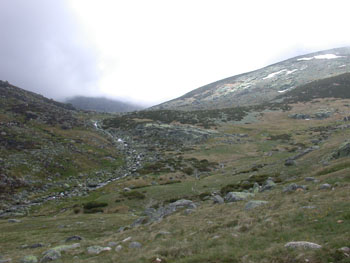 On the way we had Rock Bunting, Booted Eagle, Spanish Imperial Eagle, 2 Cuckoo and a Red Kite. As the weather was not too brilliant, with low cloud and a cold easterly wind, we drove straight to the car park, nearly 12 kms along the road to Laguna Grande de Gredos. In the car park we had our first Dunnock of the trip and as we walked up the steep path towards the summit we added Northern Wheatear, Black Redstart, Spectacled Warbler, Lesser Whitethroat, Bluethroat, Yellow Wagtail (iberiae), Water Pipit, Chough and Skylark to our list. Many of the Bluethroat were sat on the tops of small bushes and engaging in short upward display flights. Our main target here had been Rock Thrush, but with the weather closing in and rain threatening we cut short our visit and headed back down to civilisation. In meadows on the way we had good views of a singing Woodlark and returning to spend 30 minutes at Puente del Duque (there had been two coach loads of kids there on the way up) we picked up Coal Tit, Goldcrest, Grey Wagtail, Dipper and a party of c10 young Crossbill feeding on the pine cones above our heads.
On the way we had Rock Bunting, Booted Eagle, Spanish Imperial Eagle, 2 Cuckoo and a Red Kite. As the weather was not too brilliant, with low cloud and a cold easterly wind, we drove straight to the car park, nearly 12 kms along the road to Laguna Grande de Gredos. In the car park we had our first Dunnock of the trip and as we walked up the steep path towards the summit we added Northern Wheatear, Black Redstart, Spectacled Warbler, Lesser Whitethroat, Bluethroat, Yellow Wagtail (iberiae), Water Pipit, Chough and Skylark to our list. Many of the Bluethroat were sat on the tops of small bushes and engaging in short upward display flights. Our main target here had been Rock Thrush, but with the weather closing in and rain threatening we cut short our visit and headed back down to civilisation. In meadows on the way we had good views of a singing Woodlark and returning to spend 30 minutes at Puente del Duque (there had been two coach loads of kids there on the way up) we picked up Coal Tit, Goldcrest, Grey Wagtail, Dipper and a party of c10 young Crossbill feeding on the pine cones above our heads.
Madre de las Marismas del Rocio
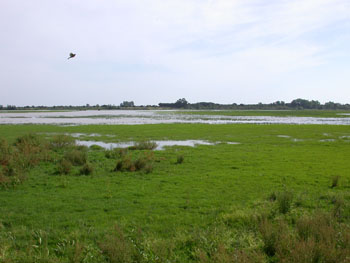 The marsh always contained good numbers of Spoonbill, Greater Flamingo and Whiskered Tern, with occasional feeding Black Tern, Black-winged Stilt and a small selection of ducks, including Red-crested Pochard. Great Reed Warbler could invariably be found singing around the marshy edges and, with the hotel not even a stone’s throw away from the water, we spent a small time here each day. The promenade running beside the marsh gives excellent views, as does a raised platform area outside the Toruno Hotel. Another good vantage point is the burnt-out SEO bird observatory at the eastern end of the promenade. The rooftop terrace of the building is still accessible and gives good elevated views of most of the marsh. As we waited for the Aires de Donana Restaurante to open for the evening on 9th May three Purple Heron flew overhead as a Woodchat Shrike perched on the fence posts at the side of the restaurant and two Red Deer wandered through the marsh edge into the surrounding fields in the distance.
The marsh always contained good numbers of Spoonbill, Greater Flamingo and Whiskered Tern, with occasional feeding Black Tern, Black-winged Stilt and a small selection of ducks, including Red-crested Pochard. Great Reed Warbler could invariably be found singing around the marshy edges and, with the hotel not even a stone’s throw away from the water, we spent a small time here each day. The promenade running beside the marsh gives excellent views, as does a raised platform area outside the Toruno Hotel. Another good vantage point is the burnt-out SEO bird observatory at the eastern end of the promenade. The rooftop terrace of the building is still accessible and gives good elevated views of most of the marsh. As we waited for the Aires de Donana Restaurante to open for the evening on 9th May three Purple Heron flew overhead as a Woodchat Shrike perched on the fence posts at the side of the restaurant and two Red Deer wandered through the marsh edge into the surrounding fields in the distance.
El Acebuche
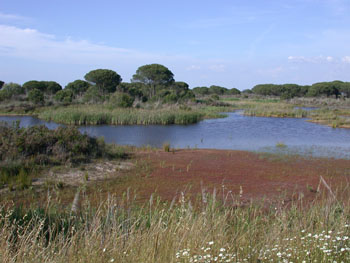 Our first visit on 6th May yielded a single Glossy Ibis, Common Sandpiper, Little Bittern and Black-crowned Night Heron as well as a few more common species, whilst Golden Oriole was heard in passing. We returned on 7th and found Southern Grey Shrike, Little Ringed Plover and our only Pied Flycatcher of the trip. Overall however we found this site generally disappointing. Apart from the Laguna del Acerbuche, which held plenty water, the other lagoons were bone dry and bird numbers, apart from Azure-winged Magpies, were not great. There is however a new visitor centre with facilities and a café.
Our first visit on 6th May yielded a single Glossy Ibis, Common Sandpiper, Little Bittern and Black-crowned Night Heron as well as a few more common species, whilst Golden Oriole was heard in passing. We returned on 7th and found Southern Grey Shrike, Little Ringed Plover and our only Pied Flycatcher of the trip. Overall however we found this site generally disappointing. Apart from the Laguna del Acerbuche, which held plenty water, the other lagoons were bone dry and bird numbers, apart from Azure-winged Magpies, were not great. There is however a new visitor centre with facilities and a café.
Palacio de Acebron
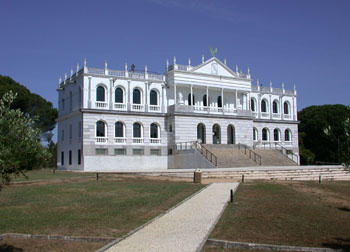 We decided to go for a walk in the woods around the Palacio straight after breakfast on 7th . On the road from La Rocina to the Palacio we saw our only 2 Hawfinch of the trip along with Dartford Warbler and Sardinian Warbler. In the woods we found Short-toed Treecreeper, Wren, Olivaceous Warbler, Nightingale (singing everywhere), Melodious Warbler, Crested Tit, Blackcap and Rufous Scrub Robin. At the Palacio itself there are toilets and it is possible to walk round the magnificent building. Numerous House Martin breed under the eves and we managed to get our only fleeting glimpse of a male Golden Oriole here, as well as a passing Honey Buzzard. We returned to the track between La Rocina and the Palacio on three separate occasions at around 20.00 and, driving slowly, had excellent views of Red-necked Nightjar, with birds sitting on the road in the car headlights, picking up the warmth of the day. One bird even stayed on the narrow road as we drove past, so close I could have leaned out of the door and touched it. Our best views ever of nightjar.
We decided to go for a walk in the woods around the Palacio straight after breakfast on 7th . On the road from La Rocina to the Palacio we saw our only 2 Hawfinch of the trip along with Dartford Warbler and Sardinian Warbler. In the woods we found Short-toed Treecreeper, Wren, Olivaceous Warbler, Nightingale (singing everywhere), Melodious Warbler, Crested Tit, Blackcap and Rufous Scrub Robin. At the Palacio itself there are toilets and it is possible to walk round the magnificent building. Numerous House Martin breed under the eves and we managed to get our only fleeting glimpse of a male Golden Oriole here, as well as a passing Honey Buzzard. We returned to the track between La Rocina and the Palacio on three separate occasions at around 20.00 and, driving slowly, had excellent views of Red-necked Nightjar, with birds sitting on the road in the car headlights, picking up the warmth of the day. One bird even stayed on the narrow road as we drove past, so close I could have leaned out of the door and touched it. Our best views ever of nightjar.
La Rocina
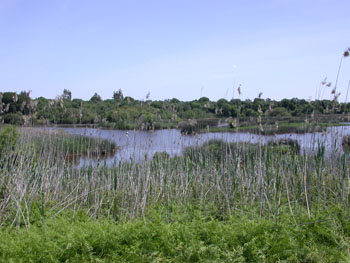
Another reserve where bird numbers were a little disappointing. The visitor centre has rest room facilities but little else. We did see our only Long-tailed Tit here, along with Cetti’s Warbler, but despite a lengthy effort, were unable to locate two singing Savi’s Warblers.
Matalascanas
Definitely the wrong place at the wrong time. We went down to the town on a Sunday evening between 18.00 and 19.00 thinking the crowds would have dispersed for the day. Wrong! The beach was still crowded and there were no birds to be seen other than a few hirundines and House Sparrow. We left fairly quickly.
The following are the sites visited in our three day trips with John Butler, which comprised principally of:-
- The northern marshes (8th May)
- The Marismas del Odiel and sites around Huelva (9th May)
- The Brazo del Este (10th May)
Lagunas de Mancho Zurillo
Two man-made reservoirs in a small flooded valley just outside Villamanrique on the way to the northern marshes, with a number of isolated dead trees ideal for roosting egrets. We saw Kingfisher, Squacco Heron, Little Egret and Black-crowned Night Heron here as we were passing through the Corredor Verde.
Corredor Verde de Guadiamar
Following the Toxic flood in April 1998 the authorities took the opportunity to buy up the effected farmland in this 5 kilometre stretch of protected land alongside the Rio Guadiamar and create a future wildlife haven which was re-opened to the public in 2002. Now good for woodland species, the area hosts a number of pairs of Black-shouldered Kites. We saw at least 10 on our first visit to the area on 8th May, along with a Common Buzzard. On 10th May, on our way to Brazo del Este we saw Melodious Warbler, Booted and Short-toed Eagle as well as more Black-shouldered Kite and a nesting colony of hundreds of Spanish Sparrow.
Turf Farm
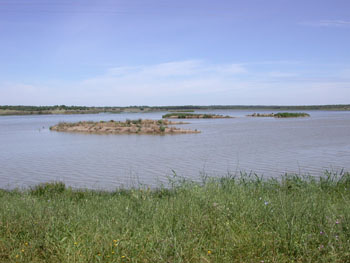
One of John’s own sites where Collared Pratincole are virtually guaranteed at the right time of year. We saw a flock of 27 in the fields along with Ringed Plover. As we drove away from the site towards the Canada de Rianzuela we saw our only Stone Curlew of the trip as it flew over the road ahead of us. There was also a flock of c200 Cattle Egrets nearby in the roadside willows.
Canada de Rianzuela
We didn’t really get the opportunity to bird this site which is one of the major wetland and meadow sites on the edge of the northern marshes. There are two bird hides overlooking the wetlands and the site can also be viewed by pulling off at the side of the road as we did, when we spotted White-headed Duck (a lifer) near the roadside. Spoonbill, Red-crested Pochard and Whiskered Tern were also abundant on both 8th and 10th May.
Gravel pit at La Venta del Cruce
A regular site for breeding Red-knobbed Coot (in 2006) where we saw 3 (my second lifer in quick succession), all with identification collars, along with Kingfisher and Little Grebe. The site can be viewed from the roadside.
Dehasa de Abajo
Part of the Canada de Rianzuela site where we stopped for a picnic lunch. There are a few nature trails which lead beside the lagoon and also into the nearby Stone Pine forest. The site appears to have some potential but we did not linger. A building under re-construction at the site looks as though it could become a future visitor centre.
Casa de Bombas
This is a large pumping station situated beside the Brazo de la Torre on the track leading out to the northern marshes. The tracks here have an elevated position looking over extensive reedbeds, marshes and agricultural land. In the general area we saw Raven, Azure-winged Magpie, Red-rumped Swallow, Yellow Wagtail (iberiae), Purple Swamphen and a female Montagu’s Harrier as we passed through on our way to and from the JAV Visitor Centre.
Lucio del Lobo
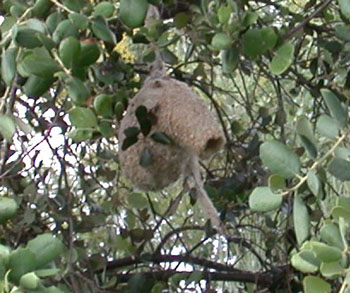
This is a large seasonal lagoon on the track leading to the JAV Visitor Centre which held a good selection of waders when we visited, including Avocet, Black-winged Stilt, Curlew Sandpiper, Redshank, Dunlin, Ruff, Ringed Plover and Grey Plover. There were also 4 Glossy Ibis and a single Black Tern among several roosting Whiskered Tern.
Jose Antonio Valverde Visitor Centre
The visitor centre is housed in an extensive building with rest rooms and a small café. The reed beds around the centre hold one of the largest and most important breeding colonies of herons and egrets in the region. We saw in excess of 50 Glossy Ibis plus good numbers of Squacco Heron, Purple Heron, Little Egret and Cattle Egret together with Greater Flamingo. Overall access to the area is however limited with two small boardwalks either side of the centre (the one nearest the main nesting colony is closed during the breeding season).
Cano de Guadiamar
This site lies further along the track past the JAV Visitor Centre and is in the heart of the northern marshes. The area includes shallow lagoons, marshes, river, reedbeds, scrub and agricultural land, is totally flat and allows almost uninterrupted views of the numerous species breeding here. As we watched, a kettle of up to 100 Griffon Vultures spiralled in the distance and a flock of c100 Collared Pratincole passed by. We saw at least 4 Little Bittern together with good numbers of Black-necked Grebe, White-headed Duck, Red-crested Pochard and a selection of ducks and water birds. Whilst trying to locate a singing Savi’s Warbler (which eventually gave us brief views) we were treated to a Short-toed Eagle flying about 10 metres above our heads. Great Reed Warblers were singing all around us as we watched a good selection of waders including most of those seen at Lucio del Lobo and Common Sandpiper.
Niebla
On our way to Huelva we stopped off near Niebla at a regular site for Montagu’s Harrier, where we saw two males together with Raven, Common Buzzard and Red-rumped Swallow. We then went to Niebla castle to see the nesting Lesser Kestrel colony with numerous attendant Spotless Starling and both Common and Pallid Swift.
Laguna de Balustrera
Moving on from Niebla we visited working gravel pits and the Laguna near the Rio Tinto, where we saw Stonechat, Purple Heron and Raven. Birds were a little scarce on the ground, but as we left and continued our journey we had a male Montagu’s Harrier and a Black-shouldered Kite.
San Juan del Puerto
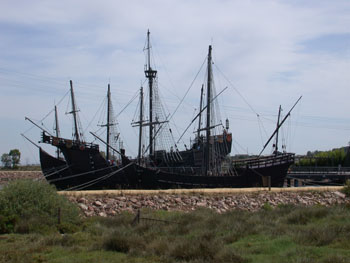
We stopped at this site near the mouth of the Rio Tinto where there are tidal marshes and some small roadside pools. The area was generally disappointing with few birds apart from a couple of Redshank, Stonechat, Whinchat, Yellow Wagtail (iberiae) and a quartering Marsh Harrier.
La Rabida
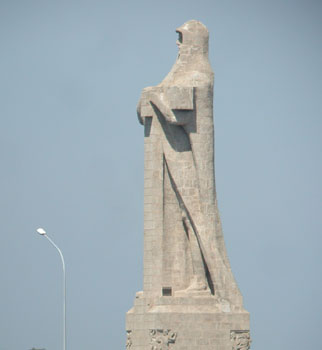
This site is at the head of the tidal estuary of the Rio Tinto just outside Huelva. A huge statue of Christopher Columbus overlooks the river and nearby are life-size models of the three ships in which he discovered “the new world” together with a maritime museum. The tide was well in and bird numbers were small. We did however manage Little Egret, Whimbrel, Sanderling, Turnstone, Fan-tailed Warbler and Spoonbill.
Laguna El Portil
This is a large lagoon on the outskirts of Huelva where there is a convenient lay-by to park. The lagoon is surrounded by Stone Pine forests and reedbeds. Black Tern were hawking over the water along with numerous hirundines including Pallid Swift and several duck species were present, including Red-crested Pochard. A Reed Warbler sang its heart out in the reeds immediately below our watch point and at least 2 Hoopoe were constantly crossing the lagoon feeding young.
Marismas de Rio Pedras/El Rompido
Near the new golf complex just outside El Rompido we visited further marshes and pools alongside the tidal river. Shorebirds were at a premium as the tide was almost at its fullest. We saw Turnstone and Whimbrel amongst the few waders, but did spot our first Cormorant of the trip along with a few Sandwich Terns sat on pilings and several Little Terns floating overhead. A singing Sardinian Warbler sat obligingly on top of a nearby bush.
Marismas del Odiel
This is a vast tidal marshland area, west of Huelva, on the banks of the Rio Odiel which stretches across three islands as the river meanders out into the Atlantic Ocean. At the start of the marshes there are a number of saltpans and roadside pools which held good numbers of waders. We had male Montagu’s Harrier, Pallid Swift and a single Red-knobbed Coot without a collar, along with Kentish Plover, Grey Plover, Curlew Sandpiper and Turnstone, together with 2 totally unexpected Shelduck. Hunting Marsh Harrier quartered the area and as we moved closer to the Atlantic we came across Sanderling, Sandwich Tern, Knot, Bar-tailed Godwit and the occasional Black-headed Gull. Amongst the roost of Yellow-legged Gulls near the mouth of the river we found at least 10 Audouin’s Gull including several in full summer plumage. Two or three Cormorant were roosting enjoying the sunshine, whilst a nesting colony of Little Tern busied themselves nearby.
Jardines Botanico de Buitrago near Aznalcollar
Our first stop on our final trip with John was on the edge of the Corredor Verde. The Gardens held numerous singing Nightingale and Quail could be heard in the distance. Several Spotted Flycatcher were on territory as were Woodchat Shrike. As we travelled on, near Canada de Rianzuela we saw Great Reed Warbler, Fan-tailed Warbler and Greenshank amongst others.
Brazo del Este Natural Park and the east bank of the Rio Guadalquivir
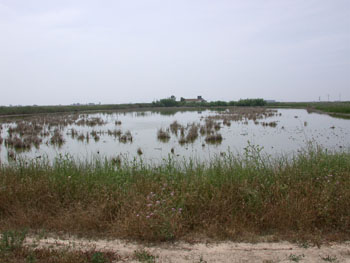 This is an extensive wetland, marsh and reedbed area, surrounded by scrub and agricultural land on the eastern bank of the Rio Guadalquivir. The density of Purple Swamphen here has to be seen to be believed. We spent a hot afternoon here but saw some excellent birds including Kentish Plover, Sanderling, Little Stint, Wood Sandpiper, Grey Plover, Collared Pratincole, Short-toed Lark, Gull-billed Tern, Marsh Harrier, Red-crested Pochard, Squacco Heron, Black-crowned Night Heron and numerous Purple Heron. Great Reed Warbler, Fan-tailed Warbler and Melodious Warbler were also present, but the star of the show for me was ten Marbled Duck, my final lifer of the trip. John had not seen any Marbled Duck for the previous two weeks as they tend to be secretive and stay within the reeds when breeding.
This is an extensive wetland, marsh and reedbed area, surrounded by scrub and agricultural land on the eastern bank of the Rio Guadalquivir. The density of Purple Swamphen here has to be seen to be believed. We spent a hot afternoon here but saw some excellent birds including Kentish Plover, Sanderling, Little Stint, Wood Sandpiper, Grey Plover, Collared Pratincole, Short-toed Lark, Gull-billed Tern, Marsh Harrier, Red-crested Pochard, Squacco Heron, Black-crowned Night Heron and numerous Purple Heron. Great Reed Warbler, Fan-tailed Warbler and Melodious Warbler were also present, but the star of the show for me was ten Marbled Duck, my final lifer of the trip. John had not seen any Marbled Duck for the previous two weeks as they tend to be secretive and stay within the reeds when breeding.
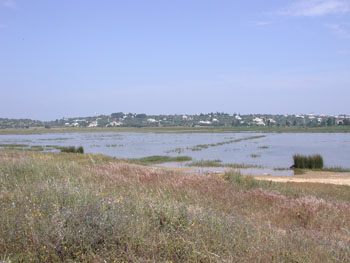 Immediately across the border we initially dropped in to Castro Marim for a couple of hours. With plenty of time before our flight home we decided to put a few extra miles on the clock and visit one of our favourite sites further west. We were able to spend about an hour at Pera, where the water levels were much higher than we had seen on any of our previous visits. The site still appears threatened by development all around but is hanging on for the time being. We only managed one Purple Swamphen but saw 5 tern species with Little, Sandwich, Gull-billed, Whiskered and Black all showing delightfully well. Waders included Turnstone, Whimbrel, Sanderling, Ringed, Grey and Kentish Plover.
Immediately across the border we initially dropped in to Castro Marim for a couple of hours. With plenty of time before our flight home we decided to put a few extra miles on the clock and visit one of our favourite sites further west. We were able to spend about an hour at Pera, where the water levels were much higher than we had seen on any of our previous visits. The site still appears threatened by development all around but is hanging on for the time being. We only managed one Purple Swamphen but saw 5 tern species with Little, Sandwich, Gull-billed, Whiskered and Black all showing delightfully well. Waders included Turnstone, Whimbrel, Sanderling, Ringed, Grey and Kentish Plover.
Finally we returned to Faro and still with time to spare, went along to the beach and salt pans immediately after the airport perimeter fence on the Rio Formosa. Unfortunately the tide was fully in and there were very few birds around apart from“Comic” Tern hunting in the distance. Ah well, time to go home!
SUMMARY
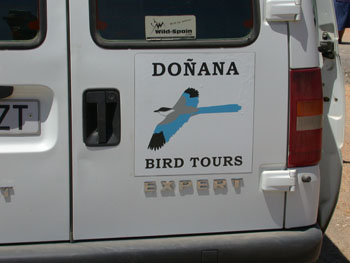
In birding terms a memorable 10 days with 179 species seen in total including 3 lifers (plus a further 4 species only heard). Spanish beds are not the most comfortable however and although we love Extremadura and may return, I can’t see us ever revisiting Donana and El Rocio in particular, although it’s an area I’ve always wanted to go to and am glad we did. Many thanks to John Butler for his expertise with the birds, their habitats and especially the sites, some of which are not the easiest to find. Sadly, John passed away in 2007.
Species List
| Bird | Species | Comments |
| Little Grebe | Tachybaptus ruficollis | Small numbers seen most days in suitable habitats |
| Great Crested Grebe | Podiceps cristatus | Seen most days in suitable habitat |
| Black-necked Grebe | Podiceps nigricollis | Upto 10 birds seen at Cano de Guadiamar |
| Gannet | Morus bassanus | Passage of 100+ birds heading west early am at Tavira on 2nd |
| Cormorant | Phalacrocorax carbo | A few birds seen in Portugal and around Huelva marshes |
| Grey Heron | Ardea cinerea | Common everywhere in small numbers |
| Purple Heron | Ardea purpurea | Single bird seen at Embalse de Arroyocampo with good numbers in Donana especially at JAV Visitor Centre and Brazo del Este |
| Great White Egret | Ardea alba | One bird only at Embalse de Arroyocampo |
| Little Egret | Egretta garzetta | Good numbers seen most days in suitable habitats |
| Squacco Heron | Ardeola ralloides | Single birds seen at several sites in Donana with greatest numbers at Brazo del Este and JAV Visitor Centre |
| Cattle Egret | Bubulcus ibis | Common everywhere with occasional roosts of 200+ birds both in Extremadura and Donana |
| Black-crowned Night Heron | Nycticorax nycticorax | Birds seen at Embalse de Arroyocampo and several sites in Donana |
| Little Bittern | Ixobrychus minutus | Single birds at Embalse de Arroyocampo, El Acebuche and El Portil with 4+ at JAV Visitor Centre |
| Black Stork | Ciconia nigra | Single bird seen near Portilla del Tietar |
| White Stork | Ciconia ciconia | Common everywhere |
| Glossy Ibis | Plegadis falcinellus | Single bird at El Acerbuche with 4 at Lucio del Lobo and a sizeable nesting colony at JAV Visitor Centre |
| Spoonbill | Platalea leucorodia | Small numbers seen most days in suitable habitats with biggest concentration of 50+ birds at El Rocio marshes |
| Greater Flamingo | Phoenicopterus roseus | 100+ birds at Madre de las Marismas del Rocio plus small numbers at JAV Visitor Centre |
| Common Shelduck | Tadorna tadorna | Pair seen at Marismas del Odiel on 9th plus several at Pera Marsh on 11th |
| Gadwall | Anas strepera | Few birds lingering at Madre de las Marismas del Rocio and El Portil |
| Mallard | Anas platyrhynchos | Common Everywhere |
| Shoveler | Anas clypeata | Again a few birds lingering at El Rocio and Canada de Rianzuela |
| Marbled Teal | Marmaronetta angustirostris | 10 birds seen at Brazo del Este on 10th May |
| Red-crested Pochard | Netta rufina | Few birds seen daily at various sites in Donana |
| Common Pochard | Aythya ferina | Relatively common at several sites in Donana |
| White-headed Duck | Oxyura leucocephala | Up to 3 birds seen at Canada de Rianzuela on 8th & 10th with single bird at Cano de Guadiamar on 8th |
| Osprey | Pandion haliaetus | Only sighting a single bird perched on a fence post at Madrigalejo |
| Honey-buzzard | Pernis apivorus | Single bird at Palacio de Acebron plus 4 on road to Villamanrique on 7th |
| Black-shouldered Kite | Elanus caeruleus | Pair at Embalse de Arroyocampo on 4th plus single bird nera Niebla on 9th with 10+ birds in the Corredor Verde |
| Red Kite | Milvus milvus | Birds seen daily in Extremadura with singles near El Rocio on 7th and Lucio del Lobo and Cano de Guadiamar on 8th |
| Black Kite | Milvus migrans | Common Everywhere |
| Egyptian Vulture | Neophron percnopterus | Pair seen at Mirador de la Bascula on 3rd |
| Griffon Vulture | Gyps fulvus | Common in Extremadura & c100 birds seen on 6th near JAV Visitor Centre |
| Black Vulture | Aegypius monachus | Single birds seen at Belen Plains & Monfrague on 3rd |
| Short-toed Eagle | Circaetus gallicus | Pair near Torrejon el Rubio on 3rd & single birds at Cano de Guadiamar on 8th and in Corredor Verde on 10th |
| Marsh Harrier | Circus aeruginosus | Few birds seen regularly in appropriate habitat |
| Montagu’s Harrier | Circus pygargus | Majority of birds seen were males near Trujillo and in appropriate habitat in Donana |
| Common Buzzard | Buteo buteo | Single bird seen near Zorita on 2nd with daily sightings, but only few birds in Donana |
| Spanish Imperial Eagle | Aquila adalberti | Single bird seen at Portilla del Tietar on 3rd with another in Sierra de Gredos on 5th |
| Golden Eagle | Aquila chrysaetos | Single birds seen near Santa Marta de Magasca on 3rd and on road from Trujillo to Monroy on 4th |
| Booted Eagle | Aquila pennatus | Few birds seen most days |
| Lesser Kestrel | Falco naumanni | Good numbers at nesting colonies in Trujillo and Niebla |
| Common Kestrel | Falco tinnunculus | Common everywhere |
| Red-legged Partridge | Alectoris rufa | Few birds seen regularly at Castro Marim and in Extremadura |
| Quail | Coturnix coturnix | Birds heard calling at Madrigalejo, Finca Santa Marta and Jardines Botanico de Buitrago |
| Little Crake | Porzana parva | Single bird seen briefly at Embalse de Arroyocampo |
| Purple Swamphen | Porphyrio porphyrio | Few birds seen at Embalse de Arroyocampo with good numbers in appropriate habitat in the Donana marshes |
| Moorhen | Gallinula chloropus | Common in appropriate habitat |
| Red-knobbed Coot | Fulica cristata | Three collared birds at La Venta del Cruce Gravel Pit and a single bird at Marismas del Odiel |
| Coot | Fulica atra | Common everywhere in appropriate habitat |
| Great Bustard | Otis tarda | Two bird seen on Belen Plains |
| Little Bustard | Tetrax tetrax | Birds heard calling on Belen Plains |
| Black-winged Stilt | Himantopus himantopus | Common everywhere in appropriate habitat |
| Avocet | Recurvirostra avosetta | Common in Portugal and in Donana |
| Stone-curlew | Burhinus oedicnemus | Single bird seen in flight near the Turf Farm |
| Collared Pratincole | Glareola pratincola | Few birds seen in flight in Corredor Verde with 27 at the Turf Farm and up to 100 birds in flight at Cano de Guadiamar on 8th, plus two birds at Brazo del Este on 10th |
| Grey Plover | Pluvialis squatarola | Few birds at Castro Marim on 2nd & 11th with small numbers in Donana |
| Ringed Plover | Charadrius hiaticula | Relatively common in appropriate habitat in Portugal & Donana |
| Little Ringed Plover | Charadrius dubius | Single birds at Rio Ardila on 2nd, El Acerbuche on 7th & near Niebla on 9th |
| Kentish Plover | Charadrius alexandrinus | Few birds seen in Portugal and Donana in appropriate habitat |
| Black-tailed Godwit | Limosa limosa | Few birds at Tavira on 1st and a single bird at Castro Marim on 11th |
| Bar-tailed Godwit | Limosa lapponica | Several birds at Marismas del Odiel on 9th |
| Whimbrel | Numenius phaeopus | Small numbers at Tavira on 1st and Marismas del Odiel on 9th with two at Pera Marsh on 11th |
| Redshank | Tringa totanus | Common in appropriate habitat in Portugal and Donana |
| Greenshank | Tringa nebularia | Single birds at Tavira on 1st, Corredor Verde on 10th & Castro Marim on 11th |
| Green Sandpiper | Tringa ochropus | Only sighting a single bird on Rio Magasca on 4th |
| Wood Sandpiper | Tringa glareola | Two birds at Brazo del Este on 10th |
| Common Sandpiper | Actitis hypoleucos | Quite common in Donana |
| Turnstone | Arenaria interpres | Occasional birds seen in Portugal and at Marismas del Odiel on 9th |
| Knot | Calidris canutus | Small flock in summer plumage at Castro Marim on 2nd and also at Marismas del Odiel on 9th |
| Sanderling | Calidris alba | Few birds at Tavira on 2nd and Castro Marim on 11th and also several sites in Donana |
| Little Stint | Calidris minuta | Single bird at Castro Marim on 2nd and also at Brazo del Este on 10th |
| Curlew Sandpiper | Calidris ferruginea | Quite common in Portugal and Donana and mainly in summer plumage |
| Dunlin | Calidris alpina | Quite common in Portugal and Donana |
| Ruff | Philomachus pugnax | Single bird at Castro Marim on 2nd and also Lucio del Loboon 8th |
| Audouin’s Gull | Larus audouinii | Up to 12 birds including 3 adults at Marismas del Odiel on 9th |
| Lesser Black-backed Gull | Larus fuscus | Several birds at Tavira on 2nd |
| Yellow-legged Gull | Larus michahellis | Common in coastal areas in Portugal and Donana |
| Black-headed Gull | Larus ridibundus | A few birds seen at Marismas del Odiel on 9th |
| Gull-billed Tern | Sterna nilotica | Good numbers at Brazo del Esteon 10th and two birds at Pera Marsh on 11th |
| Sandwich Tern | Sterna sandvicensis | Birds at Tavira on 2nd, Marismas del Odiel on 9th and Pera on 11th |
| Common Tern | Sterna hirundo | Two birds only flying along river at Portilla del Tietar on 3rd |
| Little Tern | Sterna albifrons | Relatively common in Portugal and small breeding colony at Marismas del Odiel on 9th |
| Whiskered Tern | Chlidonias hybrida | Common in marshy areas in Donana and several birds at Pera Marsh on 11th |
| Black Tern | Chlidonias niger | Few birds seen daily at El Rocio plus pair at Pera on 11th |
| Wood Pigeon | Columba palumbus | Relatively common everywhere |
| Turtle Dove | Streptopelia turtur | Single bird on wires south of Madrigalejo on 2nd |
| Collared Dove | Streptopelia decaocto | Common everywhere |
| Great Spotted Cuckoo | Clamator glandarius | Pair at Tavira on 1st and near Zorita on 2nd with single bird on road to Monroy on 4th |
| Cuckoo | Cuculus canorus | Many birds heard but only three seen, all in Spain |
| Scops Owl | Otus scops | Two birds heard calling at Finca Santa Marta |
| Eagle Owl | Bubo bubo | Adult and two young at nest site at Portilla del Tietar on 3rd |
| Little Owl | Athene noctua | Pair seen at Monroy on 4th |
| Red-necked Nightjar | Caprimulgus ruficollis | Five birds seen on road between La Rocina and Palacio de Acebron on 8th and 9th |
| Alpine Swift | Tachymarptis melba | Four birds at Rio Almonte on 3rd |
| Swift | Apus apus | Common everywhere |
| Pallid Swift | Apus pallidus | Birds seen around Trujillo on 3rd, Niebla Castle and El Portil on 9th |
| Kingfisher | Alcedo atthis | Single birds at Rio Magasca on 4th, Corredor Verde and near La Vente del Cruce on 8th |
| Bee-eater | Merops apiaster | Common everywhere in small numbers |
| Roller | Coracias garrulus | Single bird at Rio Ardila on 2nd |
| Hoopoe | Upupa epops | Common everywhere in small numbers |
| Calandra Lark | Melanocorypha calandra | Several birds on Trujillo to Monroy road on 4th |
| Greater Short-toed Lark | Calandrella brachydactyla | Single bird in track-side field at Brazo del Este on 10th |
| Crested Lark | Galerida cristata | Common everywhere in suitable habitat |
| Thekla Lark | Galerida theklae | Several birds seen near Logrosan on 4th |
| Wood Lark | Lullula arborea | Bird singing in display flight near Puente del Duque on 5th |
| Sky Lark | Alauda arvensis | Few birds on Belen Plains on 3rd with good numbers on upland meadow at Laguna Grande de Gredos on 5th |
| Sand Martin | Riparia riparia | Birds seen near Trujillo on 2nd and at Cano de Guadiamar on 8th |
| Crag Martin | Ptyonoprogne rupestris | Birds common in suitable habitat in Extremadura |
| Swallow | Hirundo rustica rustica | Common everywhere |
| Red-rumped Swallow | Cecropis daurica | Small numbers seen most days |
| House Martin | Delichon urbica | Common everywhere |
| White Wagtail | Motacilla alba alba | Birds seen at Rio Magasca on 3rd, Embals de Arroyocampo on 4th and Puente del Duque on 5th |
| Spanish Yellow-wagtail | Motacilla flava iberiae | Relatively common in small numbers especially in Donana |
| Grey Wagtail | Motacilla cinerea | Single bird at Puente del Duque on 5th |
| Water Pipit | Anthus spinoletta | Single bird in summer plumage at Laguna Grande de Gredos on 5th |
| Goldcrest | Regulus regulus | Bird at Puente del Duque on 5th |
| Dipper | Cinclus cinclus | Single bird at Puente del Duque on 5th |
| Wren | Troglodytes troglodytes | Single bird seen at roadside stop on way to Extremadura on 2nd and another at Palacio de Acebron on 7th |
| Dunnock | Prunella modularis | Several birds in car park at Laguna Grande de Gredos on 5th |
| Blue Rock-thrush | Monticola solitarius | Two birds at Penafalcon on 3rd |
| Blackbird | Turdus merula | Common everywhere |
| Mistle Thrush | Turdus viscivorus | Single bird in Olive groves near Santa Marta de Magasca on 3rd |
| Zitting Cisticola | Cisticola juncidis | Small nimbers seen in appropriate habitat on 4 days |
| Cetti’s Warbler | Cettia cetti | Heard almost everywhere in appropriate habitat with good views on 3 days |
| Savi’s Warbler] | Locustella luscinioides | Bird seen briefly at Cano de Guadiamar on 8th |
| Reed Warbler | Acrocephalus scirpaceus | Birds seen at Embalse de Arroyocampo and several sites in Donana |
| Great Reed Warbler | Acrocephalus arundinaceus | Birds seen at Embalse de Arroyocampo and several sites in Donana – easier to see than Reed Warbler |
| Western Olivaceous Warbler | Hippolais opaca | Two birds seen at Palacio de Acebron 7th |
| Melodious Warbler | Hippolais polyglotta | Bird at Finca Santa Marta on 2nd and Palacio de Acebron on 5th with a few in Corredor Verde on 10th |
| Willow Warbler | Phylloscopus trochilus | Single bird at Madrigalejo on 2nd |
| Blackcap | Sylvia atricapilla | Frequently heard but seen en route to Extremadura on 2nd and Palacio de Acxebron on 7th |
| Garden Warbler | Sylvia borin | Bird singing in deep scrub at Finca Santa Marta |
| Common Whitethroat | Sylvia communis | Single bird seen singing in hedgerow on Belen Plains on 3rd |
| Lesser Whitethroat | Sylvia curruca | Single bird in roadside bushes near Laguna Grande de Gredos on 5th |
| Sardinian Warbler | Sylvia melanocephala | Birds seen on most days but not in any great numbers |
| Spectacled Warbler | Sylvia conspicillata | Single bird near Laguna Grande de Gredos on 5th |
| Dartford Warbler | Sylvia undata | Several birds in scrub near Palacio de Acebron on 7th |
| Spotted Flycatcher | Muscicapa striata | Up to 3 birds in Jardines Botanico de Buitrago on 10th |
| Pied Flycatcher | Ficedula hypoleuca | Single female at El Acerbuche on 7th |
| Robin | Erithacus rubecula | Only two birds seen on way to Extremadura on 2nd and on way to Sierra de Gredos on 5th |
| Nightingale | Luscinia megarhynchos | Numerous birds heard every day with good sightings on at least 4 occasions |
| Red-spotted Bluethroat | Luscinia svecica svecica | Up to 8 birds seen at Laguna Grande de Gredos on 5th |
| Rufous-tailed Scrub-robin | Cercotrichas galactotes | Single bird at Palacio de Acebron on 7th |
| Black Redstart | Phoenicurus ochruros | Single male at Laguna Grande de Gredos on 5th |
| Whinchat | Saxicola rubetra | Birds seen at Zorita on 2nd, near El Rocio on7th and at San Juan del Puerto on 9th |
| Stonechat | Saxicola rubicola | Birds seen daiily in appropriate habitat |
| Northern Wheatear | Oenanthe oenanthe | Single bird seen near Santa Marta de Magasca on 3rd and Laguna Grande de Gredos on 5th |
| Black-eared Wheatear | Oenanthe hispanica | Single bird seen singing on road to Mirador de la Bascula on 3rd |
| Long-tailed Tit | Aegithalos caudatus | Small floock seen at La Rocina on 7th |
| Coal Tit | Periparus ater | Birds seen around Puente del Duque on 5th |
| Crested Tit | Lophophanes cristatus | Single bird at Palacio de Acebron on 7th |
| Great Tit | Parus major | Birds relatively common in Extremadura and Donana |
| Blue Tit | Cyanistes caeruleus | Only seen on 3 days at Rio Magasca and Palacio de Acebron |
| Nuthatch | Sitta europaea | Single bird on 2nd in wooded lay-by on N435 in Spain |
| Short-toed Treecreeper | Certhia brachydactyla | Single bird at Palacio de Acebron on 7th |
| Penduline Tit | Remiz pendulinus | Adult at Embalse de Arroyocampo on 4th, followed by adult and 4 young on 5th |
| Golden Oriole | Oriolus oriolus | Heard several times but fleeting glimpse of male only at Palacio de Acebron on 7th |
| Southern Grey Shrike | Lanius meridionalis | Seen daily in Extremadura with fewer birds evident in Donana |
| Woodchat Shrike | Lanius senator | Few birds seen almost daily in appropriate habitat |
| Jay | Garrulus glandarius | Two birds seen flying across roads in Portugal plus pair in Sierra de Gredos on 5th |
| Azure-winged Magpie | Cyanopica cyana | Relatively common everywhere in appropriate habitat |
| Magpie | Pica pica | Common everywhere |
| Chough | Pyrrhocorax pyrrhocorax | Four birds at Laguna Grande de Gredos on 5th |
| Jackdaw | Corvus monedula | Seen relatively regulary but by no means common |
| Carrion Crow | Corvus corone | Birds seen near Santa Marta de Magasca on 3rd and at Laguna Grande de Gredos on 5th |
| Raven | Corvus corax | Birds seen on 5 days both in Extremadura and Donana |
| Spotless Starling | Sturnus unicolor | Common everywhere |
| House Sparrow | Passer domesticus | Common everywhere |
| Spanish Sparrow | Passer hispaniolensis | Small flock at Embalse de Arroyocampo on 4th & 5th with flock of 200+ in Corredor Verde breeding colony on 10th |
| Tree Sparrow | Passer montanus | Few birds seen in Corredor Verde de Guadiamar on 8th |
| Rock Sparrow | Petronia petronia | Single female in Sierra de Gredos on 5th with four young on wires nearby |
| Red Avadavat | Amandava amandava | Mobile flock of up to 40 birds at Madrigalejo on 2nd |
| Chaffinch | Fringilla coelebs | Relatively scarce with birds only seen on 3 days |
| Common Crossbill | Loxia curvirostra | Flock of up to 10 juveniles seen feeding at Puente del Duque on 5th |
| Greenfinch | Carduelis chloris | Again, not too common with few birds only seen on 4 days |
| Siskin | Carduelis spinus | Single bird seen with Goldcrest at Puente del Duque on 5th |
| Goldfinch | Carduelis carduelis | Common everywhere |
| Linnet | Acanthis cannabina | Few birds seen at Tavira, Sierra de Gredos and in Donana |
| Serin | Serinus serinus | Common everywhere in appropriate habitat |
| Hawfinch | Coccothraustes coccothraustes | Pair seen at roadside om way from La Rocina & Palacio de Acebron on 7th |
| Rock Bunting | Emberiza cia | Birds seen at Penafalcon on 3rd and Sierra de Gredos on 5th |
| Corn Bunting | Emberiza calandra | Common everywhere |
David and Amanda Mason
